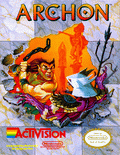
































Archon: The Light and the Dark

Archon: The Light and the Dark is a 1983 video game developed by Free Fall Associates and one of the first five games published by Electronic Arts. It's similar in concept to Chess, except that landing on another player's piece results in an arcade-style fight to determine the victor. Archon was originally developed for Atari 8-bit computers, then ported to the Apple II, Commodore 64, Amstrad CPC, ZX Spectrum, Amiga, IBM PC, Apple Macintosh, PC-88, and NES. It was designed by Paul Reiche III (who also created the graphics for the game) and Jon Freeman, and programmed by Anne Westfall.
The goal of the game is either to take control of five power points located on the board, to eliminate all the opposing pieces, or to eliminate all but one remaining imprisoned piece of the opponent's.
While the board is similar to a chessboard, and the various pieces are similarly designed to have various offsetting abilities, when one piece attempts to take another, the removal of the targeted piece is not automatic. Instead, the two pieces are placed into a full-screen 'combat arena' and must battle (action-style, with the players running the pieces) to determine who takes the square.
Generally (but not always) in combat, a stronger piece will defeat a weaker piece in either defending or capturing a square. It is also possible for the fight to result in a double-kill, in which both pieces are eliminated. This uncertainty adds a level of complexity into the game, since it is not always possible to predict if taking a square will be successful. Different pieces have different abilities in the combat phase. These include movement, lifespan, and weapon damage and attributes. The weapons vary by range, speed, rate-of-fire, and power. For example, the pawn (represented by knights on the 'light' side and goblins on the 'dark' side) attacks quickly, but has very little strength; its weapon, a sword or club, has limited reach and power. A dragon is considerably stronger and can attack from a distance, while a golem moves slowly and fires a slow but powerful boulder.
In addition, the damage-taking ability of any given piece is affected by the square on which the battle takes place, with each player having an advantage on squares of their own color. Many squares on the board oscillate between light and dark, making them dangerous to try and hold over long periods of time. Some of the power points are on oscillating squares.
Some pieces have special abilities. The phoenix can turn into a ball of fire, both damaging the enemy and shielding itself from enemy attacks. The shapeshifter assumes the shape and abilities of whatever piece it is up against. MikroBitti magazine once noted that the phoenix and the shapeshifter facing each other usually end up as the most boring battle in the entire game - as both combatants' capabilities are simultaneously offensive and defensive, they tend to use it whenever they meet each other, and thus both rarely get damaged.
Each side also has a spellcaster piece, who are the leaders: the sorceress for the dark side, the wizard for the light side. The sorceress and the wizard can cast seven different spells. Each spell may be used only once per game by each spellcaster.
The computer opponent slowly adapts over time to help players defeat it. The game is usually won when either one side destroys all the opposing pieces or one of the sides is able to occupy all of the five power points. More rarely, a side may also win by imprisoning its opponent's last remaining piece. If each side has but a single piece, and the two pieces destroy each other in a double-kill, then the game ends in a tie.
How to play:
Click on the joystick icon in the Archon: The Light and the Dark online emulator to see how to control the Archon: The Light and the Dark game









































Comments